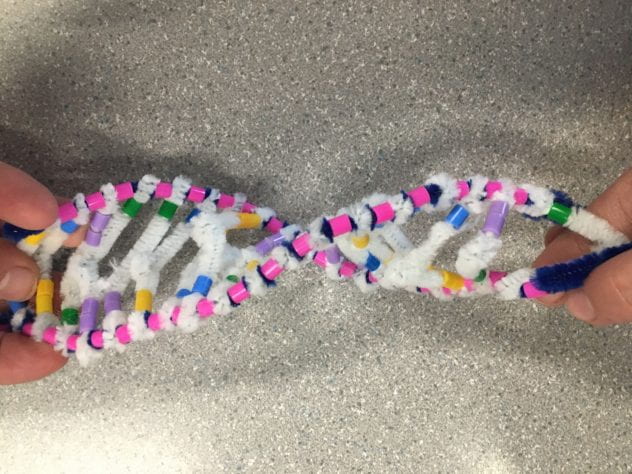
single strand of DNA molecule sugar-phosphate backbone, with nucleotides ready to hydrogen bond to their complimentary base pairings
The structure of DNA is made up of two polynucleotide anti parallel strands that are shaped into a double helix with phosphate-sugar backbones on the outside and complimentary base pairings on the inside. These base pairings, (nucleotides), are hydrogen bonded together, connecting the two strands into one DNA molecule. The bases, pyrimidines and purines, bond to each other depending on their complimentary base. Adenine always h-bonds to thymine, while cytosine always bonds to guanines
This activity helps model the structure of DNA by clearly showing the basic structure of having 2 sugar-phosphate backbones, and showing the complimentary bases bond to each other depending on which base they are. The changes we could’ve made to improve the accuracy of this model would have to be ensuring the sizes and proportions of the materials match. The model didn’t perfectly illustrate exactly how a DNA molecule would be formed, as the white pipe cleaners weren’t all the same size, therefore not creating a “consistent” bond. Also, H-bonding is a lot more complicated than just two hooks latching onto each other, which is what the model shows. The spacing of the beads (representing the bases) and the white pipe cleaners from each other were not consistent nor equally distanced. To improve this, we could treat the model with more detail and try harder to equally space and place all materials.
DNA replication occurs before a cell divides.
- Unwinding
The two strands that make up DNA “unzip” – the h-bonds (which are very weak) between the complimentary bases break. The enzyme HELICASE causes this to happen.
- Complimentary base pairing
New nucleotides, which are always present in the nucleus, fit into place with their complimentary base pairing. The enzyme POLYMERASE causes this to happen and is present.
- Joining
The complimentary base pairings all join together to form new strands, therefore new DNA molecules. This step is caused by the enzyme DNA LIGASE
This process may occur differently on the “leading” and lagging” strands because when the sugar is at the top of the strand, the parent strand is read by the DNA polymerase from the 3’ end towards the 5’ end replicates normally, but when it is the opposite (Lagging strand), the complimentary strand will need to be built by DNA polymerase in short segments moving backwards from the “replication fork”
To model the complimentary base pairing and joining of adjacent nucleotides steps of DNA replication, I used 2 new strands of blue pipe cleaners (representing the sugar phosphate backbones) lined with the replicated opposite side of bases with the beads, therefore making it able for unzipping strands to find a new strand to hydrogen bond with to form a new, replicated DNA molecule. This activity was well suited to showing this process by clearly displaying the way that the molecule unzips with the help of the enzyme polymerase. The model shows how one molecule turns into two complete copies because of this unwinding. It was inaccurate in the way it showed the hydrogen bonding and exactly where the original sugar phosphate backbone ended up and how a new one forms in a real DNA replication. Also, the true double helix shape of the molecule wasn’t possible to be kept during the model of the process since the natural shape of pipe cleaners are parallel. The complexity of the work of the enzymes weren’t able to be shown due to the simplicity of the model, yet the detailedness of the true process. Lastly, this model didn’t show that the parent DNA molecule stays in tact during this replication process




